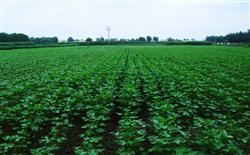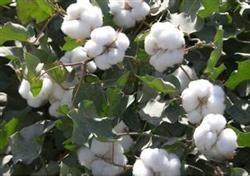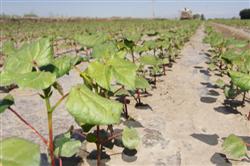Key points of cotton management in July

July is the month of the fastest growth and the largest growth of cotton, and it is also the month of drastic weather changes, many disasters and serious diseases and insect pests. Most cotton fields enter the flowering stage in early July, and by the end of July, 90% of the vegetative and reproductive organs of cotton plants have grown; the root network of cotton was also completed in July, forming a peak of absorption of mineral nutrients and water. The summer day entered in the middle of July, which is the fastest and largest month for cotton transformation. From the above aspects, the cotton management in July has the nature of a decisive battle. (1) to dig trenches to cultivate soil. It is beneficial to watering and drainage, preventing drought and waterlogging, ventilating the lower part of cotton field, reducing humidity, increasing the temperature difference between day and night, improving the microclimate of cotton field, preventing boll rot and lodging, and promoting root protection. After uncovering the plastic film in the cotton field, combined with ploughing and loosening the soil, ditching and soil cultivation should be carried out where possible, mainly by machinery and animal power, with artificial assistance. Those with intermediate ploughing foundation can be completed at one time or in two stages. The low-lying land should dredge the drainage system. (2) pruning and topping. The purpose of cotton pruning is to regulate the distribution of nutrients, improve the population structure, and finally make full use of water, fertilizer, light, gas, heat and other resources to achieve high cotton yield. The use of vegetative branches (referred to as leaf branches) should not go to extremes, either none of them will be left or none of them will go. In the cotton field with high density and no shortage of seedlings, there are basically no leaf branches, but in rare places, lack of seedlings and the edge of the ground, 1-2 strong leaf branches per plant can be left, which can increase the number of bolls per plant; it is not advisable to retain all leaf branches, and the leaf branches that have not yet appeared and whose buds are very small are resolutely removed in early July; if the leaf branches are strong and have grown fruit branches, they can beat the leaf branches immediately and can no longer let them grow. If there are too many peaches before Fuqian, it will bring many disadvantages to cotton plants, such as premature senility, stiff petals, rotten peaches and so on, so it is necessary to remove all the flowers that have bloomed at the beginning of July so that the cotton plants can save nutrients and bear more bolls when the conditions are suitable. In the cotton fields of 2500-3000 plants per mu in south-central Hebei and northwest Shandong, 13-14 fruit branches per plant should be topped in time according to soil fertility and density. Do not be afraid of shedding and greed and repeatedly postpone topping and blindly leave more fruit branches. Planting varieties with higher boll weight should seek not only higher boll number per mu, but also higher single boll weight. Do not or less early peach, late peach, will greatly improve the uniformity of cotton bolls. (3) tighten up chemical control. There is little rain in many areas of the north this year, and many cotton farmers do not dare to control it. Some cotton fields have not yet carried out the first chemical control, and most of them have the problems of late chemical control and low dose. Due to the high temperature in May and June this year, the vegetative growth is prosperous, the reproductive growth is weak, and the aboveground plants are larger and the root system is smaller. The wilting phenomenon of cotton plants occurred in some cotton fields in the first section after sunny days, and some of them were neither disease nor fertilizer damage, which were mainly caused by rapid aboveground growth, large plant size, large transpiration at high temperature and weak water absorption supply of roots. In terms of mastering the application principle of "looking at the sky, the earth, and the seedlings", we should give priority to "looking at the seedlings." as long as the cotton seedlings grow at a normal rate, they should be controlled on time. This is called "active chemical control." it's passive chemical control. According to the previous chemical control situation and the current cotton growth situation, it is generally necessary to control 2-3 times in July, the first time in the early flowering stage, 1-1.5 grams per mu, the second time in the full flowering stage, 1-2 grams per mu, and the third time after topping, 3-5 grams per mu. As the cotton plant is larger now, chemical control should spray the whole plant with 20-25 kg of water per mu to spray the tip of the top and middle and upper fruit branches. (4) provide fertilizer in time. The fertilization of cotton is the most complex problem in cotton management. It is by no means that the more fertilization, the higher yield. Sometimes improper fertilization will lead to the opposite result. According to the analysis of the nutrient elements that make up the cotton plant, the yield of more than 600 jin of seed cotton per mu does not need too much nutrition, and there is a certain proportion among the nutrient elements, such as an excess of a certain element, which not only causes waste. it may also affect the absorption and utilization of other elements, so fertilization is balanced, reasonable and scientific. On the basis of applying sufficient base fertilizer, cotton generally does not need to apply quick-acting nitrogen fertilizer before blooming and setting bolls to avoid excessive vegetative body or vegetative growth; topdressing should be applied at the peak flowering stage (the fourth fruit branch blossoms), 10-15 kg urea per mu according to soil fertility and cotton plant growth; if potash fertilizer is not applied or the amount of potash fertilizer is too little, it should be applied as soon as possible. The cotton field topdressing in July can be absorbed and utilized by cotton plants on both sides of the big row. Do not apply fertilizer between small rows to avoid further damage to the originally weak root system. Every year, fertilization is too close to the cotton plant and causes wilting. For seedlings that are late due to herbicides or diseases, irrigate the plants with 1% urea water, and those that do not grow will be sprayed with gibberellin. For cotton fields with weak nutritional growth due to drought or excessive phosphorus application, urea solution should be sprayed to make the tip and fruit branch tip extend as soon as possible. After cotton topping, nutrients are given priority to supply young bolls, and the upper fruit branches are in the most easily de-fertilized state. at this time, topdressing is not only difficult, but also restricted by dry land, so foliar fertilizer spraying should be used to ensure the nutrition of cotton plants. Foliar fertilizer spraying not only saves fertilizer, but also has a fast fertilizer effect. As most cotton farmers attach importance to the input of diammonium and compound fertilizer year after year, relatively speaking, the lack of available phosphorus in soil is not serious, and the demand for phosphorus in cotton is less, so foliar fertilizer spraying should be dominated by nitrogen and potassium. Urea and potassium sulfate are the best choices, first, high content of nutrient elements, second, low cost, and third, safe use. Spray fertilizer concentration 2%, each mu with more than 1 jin of fertilizer, avoid spraying at noon, be sure to spray the back of cotton leaves wet. Spray immediately after topping, once every 8-10 days, first nitrogen and then potassium, can be sprayed until August 10-15. The principle of cotton topdressing is not to overdo it before flowering and not to lose fat after flowering. Once fattened, it is difficult to achieve the top of autumn peach. In the later stage, sufficient spraying of available potassium fertilizer twice is very important for bolls, bolls and bolls in the upper part, and potassium is indispensable for the development of cotton fiber, so potassium application can improve lint percentage, especially in cotton fields where water has accumulated in the years of heavy rainfall in summer. Potassium spraying is more necessary.
- Prev

Key measures for management of cotton boll opening period
During the boll opening period, high-yield cotton looks precocious and does not senescence prematurely, which requires boll opening in the lower part of the plant, continued flowering in the upper part, and few late buds. The robust growth of cotton, the top fruit branch flat extension, fruit branch length of 20 cm 30 cm, there are 3 buds 4. If the top fruit branch stretches up too long, buds grow, and flowers break too late, it is prosperous and greedy at night.
- Next

Key points of Comprehensive Control of Cotton Seedling Diseases
There are many kinds of diseases in cotton seedling stage, among which the most common diseases are yield blight, anthracnose and so on. The incidence rate is generally 20%-30% and 50%-90% in severe cases. Especially in early spring, cotton seedlings grow weakly and emerge slowly, which is easy to be infected by bacteria, causing a large number of rotten seeds and diseased seedlings.
Related
- The first cup of black tea in spring, the flavor and history of tea gardens in Kenya, Africa
- The computer can not only choose potatoes, but also grow tea rice. AI will grow winter oolong tea champion.
- It is not only the inflated tea bitten by insects, but also engraved with the four seasons tea in Beipu.
- The Oriental Beauty Tea Festival in Zhuxian County takes the stage at the weekend to experience the plus-size feast of oil tea.
- & quot; Oriental Beauty Tea & Exploration of Emei in Hsinchu, the hometown of quot;
- The new variety of strawberry "Tainong 1" dessert is the first choice with mellow aroma. Crimson gorgeous
- History of Tea in Taiwan: from Wild Inner Mountain to Export Tea Garden
- Two types of Taiwan Oriental Beauty Black Tea won the British three-Star Award for Childhood Tea Xiang Zhang Jiaqi changed from pilot to champion tea maker.
- Banana species and varieties: the planting history of Taiwan Xianren banana and dwarf banana is long, is banana disease resistant?
- Coffee planting Technology: Qianjie Coffee from Seedling to harvesting

